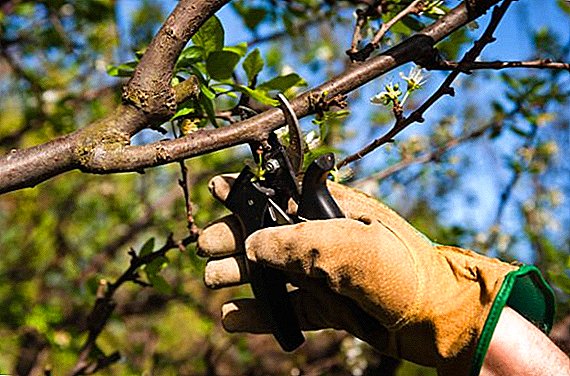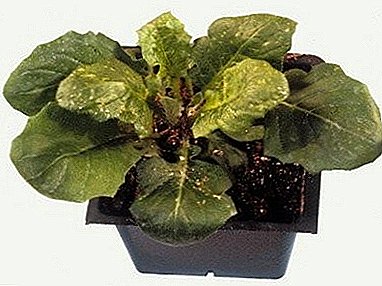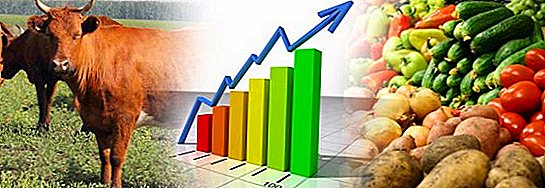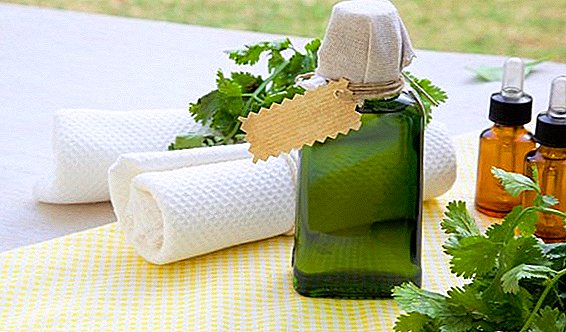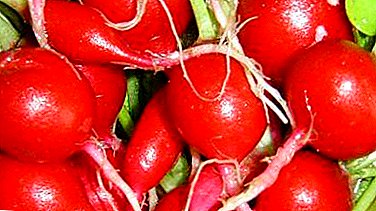
Radish has been known since ancient times. It is believed that this vegetable culture came to us from the Mediterranean Sea, and in China was known several thousand years ago.
In Europe, radishes appeared even earlier than potatoes. Currently, there is a variety of radish varieties, but one of the most popular is considered to be the hybrid variety Diego.
Further in the article you will find a detailed description of this variety and the secrets of its cultivation.
Detailed description and description
The variety Diego is a Dutch hybrid early maturing variety. Very highly productive hybrid of a radish. Suitable for cultivation in both open and protected ground. It has fairly large root crops up to 5 cm in diameter, weighing 40-70g. The fruits are very juicy, without a bitter taste, with white crisp flesh. The dark red color of the fruit is not afraid of mechanical washing and does not change color under water. The dark green plant is great for forming beams.
Diego radishes have been planted since early April. The seeds are quite cold-resistant, they can germinate already at 3-4 degrees, but the optimum temperature is 16-18 degrees.
For aging takes 20-30 days. The variety is very unpretentious in cultivation, resistant to downy mildew, to tsvetushnosti, to a number of other diseases. It is considered quite productive.
reference! Up to 4.5 kg of product is collected from 1 square meter, i.e. from 1 hectare 40-45 tons.
This variety of radish is resistant to cracking and hollowness.
Diego's variety is suitable for year-round cultivation, but is demanding of soil fertility. Loose, fertile, sandy, easily accessible soils are preferred. If the soil is poor, heavy and sour, there will be no good harvest.
Grade diego is very picky about lightin the shade goes to the arrow, gives a long tops, and the root crop does not ripen to the desired size.
The same happens with shading planting and in the presence of weeds. This vegetable crop is considered to be a long daylight plant. When the daylight is more than 14 hours radish quickly blooms.
Breeding history
 Garden radish is a favorite vegetable of all, indispensable on the spring table.
Garden radish is a favorite vegetable of all, indispensable on the spring table.
It is believed that culture was introduced from Europe by Peter I, at the end of the XVIII century, the vegetable was recognized in Russia, but radishes became widely known and applicable later.
Currently, the Russian register of breeding achievements includes 197 names of radish, of which 34 are hybrids. A large part is the merit of foreign breeding agricultural companies. At the moment, the largest areas in the open field are occupied by Diego variety.
This variety was bred by Dutch breeders who took care to create an early-ripe and at the same time very high-performance hybrid, with excellent taste and unpretentious care, as well as a beautiful presentation and good transportability.
What is the difference from other varieties?
Diego variety is very advantageous from other radish varieties., primarily because:
- provides rapid growth, and most importantly, uniform ripening of root crops in 20-30 days;
- grows well and bears fruit both indoors and outdoors;
- does not require additional lighting;
- resistant to rifle, well resists diseases and pests;
- excellent product quality, excellent transportability;
- does not have a bitter taste.
Advantages and disadvantages
Like any variety of radish Diego has a number of advantages and disadvantages.
Benefits:
- unpretentious in growing;
- cold-resistant;
- early;
- high performance;
- contains many vitamins and nutrients (including mustard oil, natural antioxidants);
- long preserves the presentation;
- forms a white crunchy core without voids and water rings;
- has good uniformity at harvest;
- has the improved properties of early ripeness and productivity;
- high ability to adapt to adverse environmental conditions;
- high genetic resistance to diseases and pests.
Disadvantages: costs more than high-quality radish seeds.
What and where is it used for?
 First of all, due to its exceptional qualities, Diego is a source of vitamins and nutrients. The first of the vegetable crops appears on the table in the spring. Mistresses are happy to use it for cooking.:
First of all, due to its exceptional qualities, Diego is a source of vitamins and nutrients. The first of the vegetable crops appears on the table in the spring. Mistresses are happy to use it for cooking.:
- okroshka;
- salads;
- cold soups;
- as a vegetable cut.
The first spring radish on the table is considered a delicacy.
Variety is considered very useful due to the content of natural antioxidants and folic acid.
The tops are used in the preparation of salads and first courses.
Growing up
Soaking seeds before sowing is not required. Begin to sow radish early in AprilSeeds germinate at 3-4 degrees and withstand spring frosts. And in 20-30 days the first fruits appear. The recommended planting scheme: 7 x 7 cm, sowing depth 2-3 cm. Seeding rate 1.5 - 2 g per 1 sq. M. After 4-8 days, the first shoots appear. Early crops watered with warm water, not more than twice a week. Otherwise, the plant can get sick with a black leg.
Lack of moisture is also fraught with and can lead to premature appearance of arrows, the fruits can lose juiciness and crispness, become tough, this is especially true in hot weather.
Attention! Sprinklers are preferred for irrigation, direct pressure from the hose is undesirable.
It is better to feed radishes before fruit formation, the presence of phosphorus in fertilizer is very important.
Harvesting and storage
Radishes are collected, as a rule, selectively, in 2-3 terms. Root crops must reach marketable sizes. After harvesting, radishes are bundled. Radishes should not be stored in a warm room, as there is a risk of moisture loss for root crops. It is recommended to store radishes in the refrigerator at 2-3 degrees, after cutting the leaves, washing and drying the roots. Under such conditions, radishes can be stored for up to 190 days.
Diseases and pests
Due to endurance and resistance to adverse natural factors and to such diseases as downy mildew, rhizoctoniosis, tsvetushnost and root rot, Diego variety suitable for all-season cultivation.
 But the cruciferous flea is considered the main enemy of this vegetable crop. It is dangerous that in the early stages of sowing can destroy almost all the plants, eating up on the shoots appeared shoots. Especially active in hot, dry weather. To combat such a pest is recommended as follows:
But the cruciferous flea is considered the main enemy of this vegetable crop. It is dangerous that in the early stages of sowing can destroy almost all the plants, eating up on the shoots appeared shoots. Especially active in hot, dry weather. To combat such a pest is recommended as follows:
- before loosening, sprinkle the mustard or ground pepper between rows (1 tsp per 1 sq. m);
- cover plants with non-woven material.
Ashes can also be used for this purpose.
Prevention of various problems
For gardeners and farmers, a very important question is how to grow the radish correctly and preserve all its best qualities provided by the breeders. How to prevent possible trouble?
- Bitter taste of radish: appears when the growing season is prolonged, i.e. you need time to harvest, to prevent the growth of root crops.
- Bursting root vegetables: Fruit cracking is the result of irregular and uneven watering.
- Hard and Fibrous Root Vegetable: The radish should grow quickly with enough moisture and a cool temperature. Hot weather and high temperatures are undesirable for this vegetable crop.
- Incorrect formation of the root: hot weather is the reason for the growth of tops.
Similar varieties of radishes
Diego is an early ripe hybrid and high-performance radish variety. For similar qualities, including the shape and taste of root vegetables, it is worth noting the following varieties:
- Dabel - very early. Root crops of a round form, as well as at Diego. Cold-resistant.
- Champion - an early ripe grade, both for an unprotected soil, and for greenhouse cultivation. Root crops of an equal form of dark scarlet color, juicy white pulp.
- 16 days - ultrafast variety for open ground and greenhouses. Spherical root vegetables, dark red, white, crunchy core. Productivity is slightly lower than Diego.
- Heat - early ripening variety, fruits are red, round, weighing up to 30 g, which is slightly less than Diego's.
- Sora - also early, early variety. Root crops are large, with a diameter of up to 5 cm, as in Diego, the taste is slightly spicy.
- Parath - It is considered one of the best varieties with spherical fruits, weight about 30 grams.
The variety of radish Diego is one of the best hybrid varieties of this vegetable, which not only surpasses its counterparts in productivity, but is also very unpretentious in cultivation and exceptional in taste. Diego deserved the attention of farmers due to the possibility of early harvesting, which allows harvesting in 2-3 terms. But all this becomes possible only due to the observance of all agrotechnical rules and recommendations.




